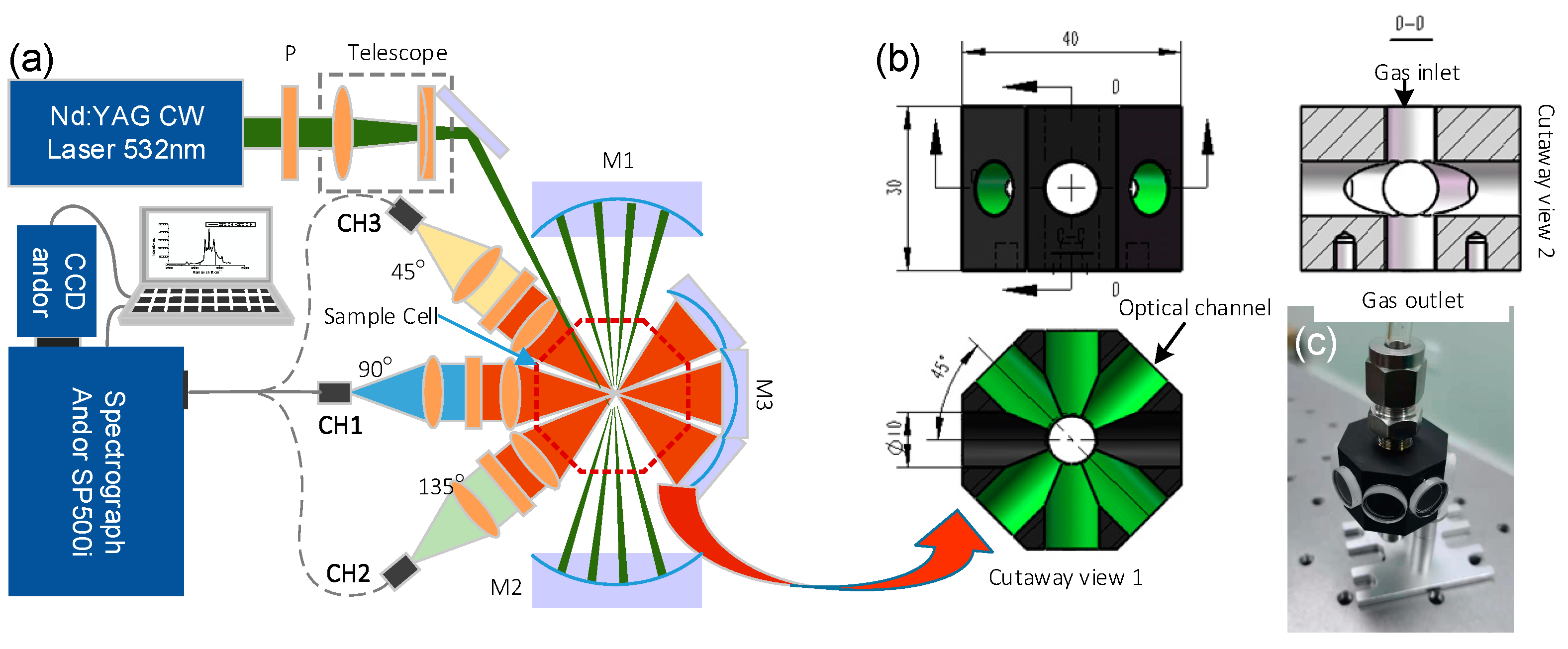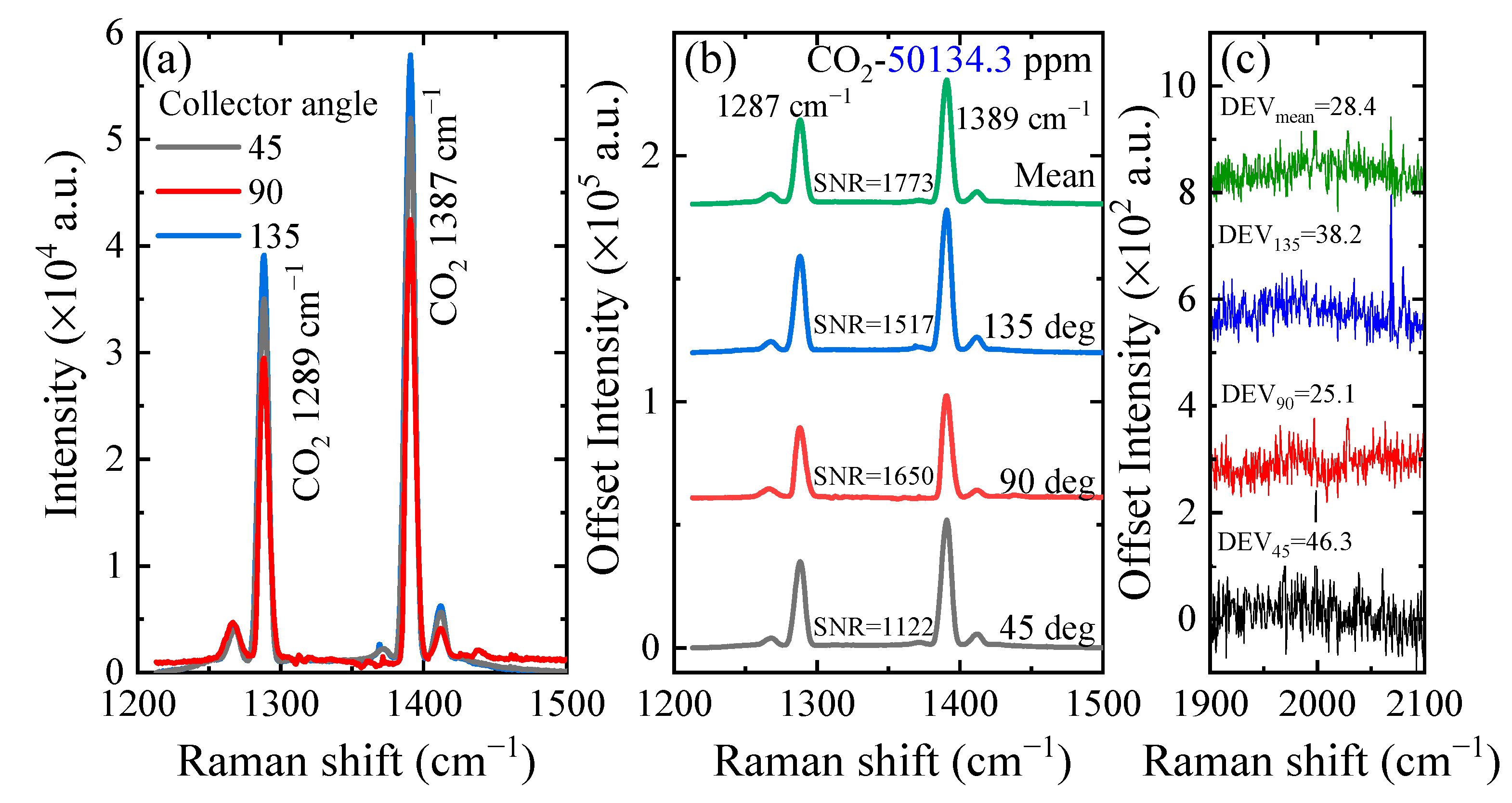Cavity Enhanced Multi-Channels Gases Raman Spectrometer
Abstract
:1. Introduction
2. Principles and Experiments
2.1. The Simulation of the Near-Concentric Cavity
2.2. Experimental Setup
3. Results and Discussion
3.1. The Distribution of Signal Intensity with Scattering Angle
3.2. The Spectra with Different Concentrations
3.3. The Limit of Detection (LOD) of This System
3.4. The Stability of This System
4. Conclusions
Author Contributions
Funding
Institutional Review Board Statement
Informed Consent Statement
Data Availability Statement
Acknowledgments
Conflicts of Interest
References
- Tang, H.; Zhu, C.; Meng, G.; Wu, N. Surface-enhanced Raman scattering sensors for food safety and environmental monitoring. J. Electrochem. Soc. 2018, 165, B3098. [Google Scholar] [CrossRef]
- Han, X.; Huang, Z.; Chen, X.; Li, Q.; Xu, K.; Chen, D. On-line multi-component analysis of gases for mud logging industry using data driven Raman spectroscopy. Fuel 2017, 207, 146–153. [Google Scholar] [CrossRef]
- Kiefer, J.; Seeger, T.; Steuer, S.; Schorsch, S.; Weikl, M.C.; Leipertz, A. Design and characterization of a Raman-scattering-based sensor system for temporally resolved gas analysis and its application in a gas turbine power plant. Meas. Sci. Technol. 2008, 19, 085408. [Google Scholar] [CrossRef]
- Sun, M.; Li, B.; Liu, X.; Chen, J.; Mu, T.; Zhu, L.; Guo, J.; Ma, X. Performance enhancement of paper-based SERS chips by shell-isolated nanoparticle-enhanced Raman spectroscopy. J. Mater. Sci. Technol. 2019, 35, 2207–2212. [Google Scholar] [CrossRef]
- Zeng, F.; Duan, W.; Zhu, B.; Mu, T.; Zhu, L.; Guo, J.; Ma, X. Paper-based Versatile SERS Chip with Smartphone-based Raman Analyzer for Point of Care Application. Anal. Chem. 2019, 91, 1064–1070. [Google Scholar] [CrossRef] [PubMed]
- Lascola, R.; Mcwhorter, S.; Murph, S.H. Apparatus for SERS Analysis of Gases. 2015-04-28. Available online: https://www.researchgate.net/publication/281434903_Apparatus_for_SERS_Analysis_of_Gases (accessed on 30 May 2021).
- Hippler, M. Cavity-enhanced Raman spectroscopy of natural gas with optical feedback cw-diode lasers. Anal. Chem. 2015, 87, 7803–7809. [Google Scholar] [CrossRef] [PubMed]
- Petrov, D.V. Multipass optical system for a Raman gas spectrometer. Appl. Opt. 2016, 55, 9521. [Google Scholar] [CrossRef] [PubMed]
- Hill, R.A.; Hartley, D.L. Focused, Multiple-pass cell for Raman scattering. Appl. Opt. 1974, 13, 186–192. [Google Scholar] [CrossRef] [PubMed]
- Hill, R.A.; Mulac, A.J.; Hackett, C.E. Retroreflecting multipass cell for Raman scattering. Appl. Opt. 1977, 16, 2004–2006. [Google Scholar] [CrossRef]
- Li, X.; Xia, Y.; Li, Z.; Huang, J. Near-confocal cavity-enhanced Raman spectroscopy for multitrace-gas detection. Opt. Lett. 2008, 33, 2143–2145. [Google Scholar] [CrossRef]
- Taylor, D.J.; Glugla, M.; Penzhorn, R.D. Enhanced Raman sensitivity using an actively stabilized external resonator. Rev. Sci. Instrum. 2001, 72, 1970–1976. [Google Scholar] [CrossRef]
- Yang, D.; Guo, J.; Liu, Q.; Luo, Z.; Yan, J.; Zheng, R. Highly sensitive Raman system for dissolved gas analysis in water. Appl. Opt. 2016, 55, 7744. [Google Scholar] [CrossRef] [PubMed]
- Miles, S.D. Gas Analysis System Having Buffer Gas Inputs to Protect Associated Optical Elements. U.S. Patent 5153671, 6 October 1992. [Google Scholar]
- Beck, K.F.; Owen, C.V. Raman Gas Analysis System with Cavity/Boss Assembly for Precision Optical Alignment. U.S. Patent 581879, 6 October 1998. [Google Scholar]
- Markin, A.V.; Markina, N.E.; Goryacheva, I.Y. Raman spectroscopy based analysis inside photonic-crystal fibers. Trac-Trend Anal. Chem. 2017, 88, 185–197. [Google Scholar] [CrossRef]
- Hanf, S.; Keiner, R.; Yan, D.; Popp, J.; Frosch, T. Fiber-enhanced Raman multigas spectroscopy: A versatile tool for environmental gas sensing and breath analysis. Anal. Chem. 2014, 86, 5278–5285. [Google Scholar] [CrossRef] [PubMed]
- Hanf, S.; Bögözi, T.; Keiner, R.; Frosch, T.; Popp, J. Fast and highly sensitive fiber-enhanced Raman spectroscopic monitoring of molecular H2 and CH4 for point-of-care diagnosis of malabsorption disorders in exhaled human breath. Anal. Chem. 2015, 87, 982–988. [Google Scholar] [CrossRef] [PubMed]
- Wang, P.; Chen, W.; Wan, F.; Wang, J.; Hu, J. A review of cavity-enhanced Raman spectroscopy as a gas sensing method. Appl. Spectrosc. Rev. 2020, 55, 393–417. [Google Scholar] [CrossRef]
- Buric, M.P.; Chen, K.P.; Falk, J.; Woodruff, S.D. Improved sensitivity gas detection by spontaneous Raman scattering. Appl. Opt. 2009, 48, 4424–4429. [Google Scholar] [CrossRef] [PubMed] [Green Version]
- Li, X.; Xia, Y.; Huang, J.; Zhan, L. Diagnosis of multiple gases separated from transformer oil using cavity-enhanced Raman spectroscopy. Chin. Phys. Lett. 2008, 25, 3326. [Google Scholar]
- Wang, P.; Chen, W.; Wan, F.; Wang, J.; Hu, J. Cavity-enhanced Raman spectroscopy with optical feedback frequency locking for gas sensing. Opt. Express 2019, 27, 33312–33325. [Google Scholar] [CrossRef] [PubMed]
- Keresztury, G. Raman Spectroscopy: Theory. In Handbook of Vibrational Spectroscopy; Chalmers, J.M., Griffiths, P.R., Eds.; Wiley: Hoboken, NJ, USA, 2002; pp. 74–78. [Google Scholar]






| Components | CO2 | O2 | N2 |
|---|---|---|---|
| Sample 1 | 98.8 ppm | 102.0 ppm | other |
| Sample 2 | 511.0 ppm | 508.2 ppm | other |
| Sample 3 | 2028.7 ppm | 1996.0 ppm | other |
| Sample 4 | 50,134.3 ppm | 0 | other |
| Sample 5 | 9.96% | 28.00% | other |
Publisher’s Note: MDPI stays neutral with regard to jurisdictional claims in published maps and institutional affiliations. |
© 2021 by the authors. Licensee MDPI, Basel, Switzerland. This article is an open access article distributed under the terms and conditions of the Creative Commons Attribution (CC BY) license (https://creativecommons.org/licenses/by/4.0/).
Share and Cite
Yang, D.; Liu, Q.; Guo, J.; Wu, L.; Kong, A. Cavity Enhanced Multi-Channels Gases Raman Spectrometer. Sensors 2021, 21, 3803. https://doi.org/10.3390/s21113803
Yang D, Liu Q, Guo J, Wu L, Kong A. Cavity Enhanced Multi-Channels Gases Raman Spectrometer. Sensors. 2021; 21(11):3803. https://doi.org/10.3390/s21113803
Chicago/Turabian StyleYang, Dewang, Qingsheng Liu, Jinjia Guo, Lulu Wu, and Andong Kong. 2021. "Cavity Enhanced Multi-Channels Gases Raman Spectrometer" Sensors 21, no. 11: 3803. https://doi.org/10.3390/s21113803





